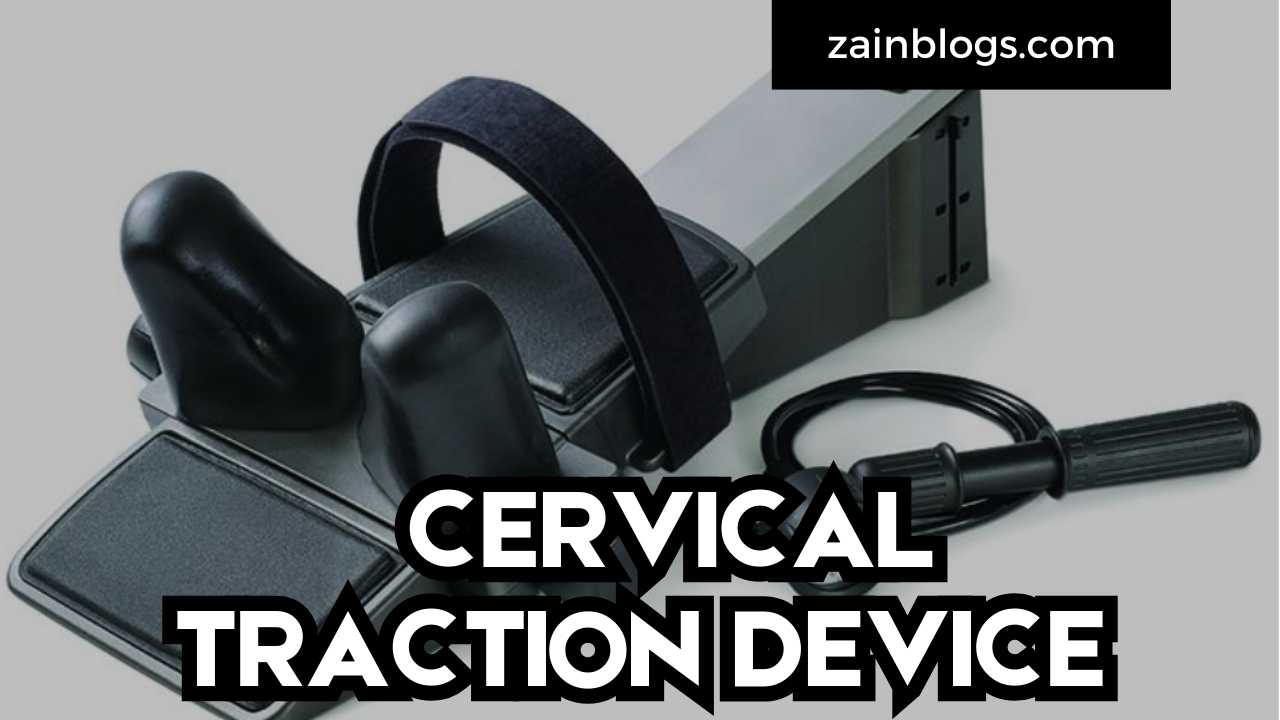Table of Contents
Introduction
When it comes to neck pain, finding relief can feel like a never-ending journey. One innovative solution gaining popularity is the cervical traction device. These devices are designed to alleviate neck pain, improve posture, and enhance overall well-being. But what exactly is a cervical traction device, and how does it work?
A cervical traction device is a tool used to stretch and decompress the cervical spine, which consists of the neck’s vertebrae. By gently pulling the head away from the neck, the device helps to create space between the vertebrae, relieving pressure on the spinal discs and nerves. This process can reduce pain, improve mobility, and promote healing. In this blog post, we’ll explore the ins and outs of cervical traction devices, their benefits, and how to use them effectively.

The Science Behind Cervical Traction
Understanding the science behind cervical traction can help you appreciate how these devices work to relieve neck pain. The cervical spine is made up of seven vertebrae, which are separated by intervertebral discs. These discs act as cushions, absorbing shock and allowing for movement. However, factors such as poor posture, injury, or degenerative conditions can cause these discs to become compressed, leading to pain and discomfort.
A cervical traction device works by applying a gentle pulling force to the head, which helps to stretch the cervical spine. This stretching creates space between the vertebrae, allowing the discs to rehydrate and regain their natural shape. Additionally, this decompression can reduce pressure on the nerves, alleviating pain and improving nerve function. By regularly using a cervical traction device, you can help maintain the health of your cervical spine and prevent future issues.
Types of Cervical Traction Devices
There are several types of cervical traction devices available, each with its own unique features and benefits. The most common types include over-the-door traction devices, inflatable neck collars, and electronic traction devices. Let’s take a closer look at each of these options.
Over-the-door traction devices are one of the most affordable and accessible options. They consist of a harness that wraps around your head and neck, attached to a pulley system that hangs over a door. By adjusting the weight, you can control the amount of traction applied. Inflatable neck collars, on the other hand, use air pressure to create traction. These devices are portable and easy to use, making them a popular choice for people who need a convenient solution. Electronic traction devices are more advanced and typically found in physical therapy clinics. They use motors to control the amount and duration of traction, providing a more precise and customizable treatment.
Benefits of Using a Cervical Traction Device
Using a cervical traction device can provide a wide range of benefits for your neck health and overall well-being. One of the most significant advantages is pain relief. By decompressing the cervical spine, these devices can reduce pressure on the nerves, alleviating pain and discomfort. This can be particularly beneficial for individuals with conditions such as herniated discs, cervical spondylosis, or nerve impingement.
Another key benefit of cervical traction devices is improved mobility. When the cervical spine is compressed, it can restrict movement and cause stiffness. By creating space between the vertebrae, traction can help restore normal movement and flexibility. Additionally, regular use of a cervical traction device can improve posture. Poor posture is a common cause of neck pain, and by aligning the spine, traction can help correct posture and prevent future issues.
How to Use a Cervical Traction Device Safely
While cervical traction devices can be highly effective, it’s essential to use them safely to avoid injury. Before starting any traction therapy, it’s crucial to consult with a healthcare professional, such as a physical therapist or chiropractor. They can help determine the appropriate type and amount of traction for your specific needs and provide guidance on proper usage.
When using a cervical traction device, it’s important to follow the manufacturer’s instructions carefully. Start with a low amount of traction and gradually increase the intensity as your body becomes accustomed to the treatment. It’s also essential to listen to your body and stop the therapy if you experience any pain or discomfort. Additionally, avoid using a cervical traction device if you have certain medical conditions, such as spinal fractures, infections, or severe osteoporosis, as traction can exacerbate these issues.

Incorporating Cervical Traction into Your Routine
To get the most out of your cervical traction device, it’s essential to incorporate it into your regular routine. Consistency is key when it comes to achieving lasting results. Aim to use your traction device for 10-15 minutes per session, 2-3 times per week. This can help maintain the health of your cervical spine and prevent future issues.
In addition to using a cervical traction device, consider incorporating other neck-friendly habits into your routine. Practicing good posture, engaging in regular exercise, and performing neck stretches can all help support the health of your cervical spine. Additionally, maintaining a healthy diet and staying hydrated can promote overall spinal health and enhance the effectiveness of your traction therapy.
Choosing the Right Cervical Traction Device for You
With so many options available, choosing the right cervical traction device can feel overwhelming. When selecting a device, consider factors such as your specific needs, budget, and preferences. For example, if you’re looking for a portable and easy-to-use option, an inflatable neck collar may be the best choice. On the other hand, if you prefer a more customizable treatment, an electronic traction device may be worth the investment.
It’s also important to read reviews and seek recommendations from healthcare professionals or individuals who have used cervical traction devices. This can provide valuable insights into the effectiveness and ease of use of different options. Ultimately, the best cervical traction device for you is one that meets your needs and fits comfortably into your routine.
Cervical Traction Devices for Chronic Neck Pain
If you suffer from chronic neck pain, a cervical traction device can be a game-changer. Chronic neck pain can significantly impact your quality of life, making it difficult to perform everyday activities and enjoy your favourite hobbies. By incorporating cervical traction into your routine, you can help manage your pain and improve your overall well-being.
Cervical traction devices work by targeting the root cause of neck pain – compression of the cervical spine. By creating space between the vertebrae, these devices can reduce pressure on the nerves and alleviate pain. Additionally, regular use of a cervical traction device can help improve posture and mobility, further reducing the risk of chronic pain. If you struggle with chronic neck pain, consider giving cervical traction a try and experience the potential benefits for yourself.
Cervical Traction for Posture Correction
In today’s digital age, poor posture is a common issue that can lead to neck pain and discomfort. Spending long hours hunched over a computer or staring at a smartphone can strain the cervical spine and cause misalignment. A cervical traction device can be an effective tool for posture correction.
By gently stretching and decompressing the cervical spine, a cervical traction device can help realign the vertebrae and promote proper posture. Regular use of the device can train your muscles and joints to maintain a healthier alignment, reducing the risk of neck pain and improving overall comfort. If you find yourself slouching or experiencing neck pain due to poor posture, incorporating cervical traction into your routine can make a significant difference.

Cervical Traction for Athletes
Athletes often put their bodies through intense physical stress, which can lead to neck pain and injuries. Whether you’re a professional athlete or a weekend warrior, a cervical traction device can be a valuable addition to your recovery toolkit.
Cervical traction can help athletes by reducing muscle tension, alleviating pain, and improving mobility. The gentle stretching action of the device can release tight muscles and promote relaxation, aiding in recovery after strenuous workouts. Additionally, by creating space between the vertebrae, cervical traction can reduce the risk of nerve impingement and other neck-related injuries. If you’re an athlete looking to optimize your recovery and prevent neck pain, consider incorporating a cervical traction device into your routine.
The Role of Cervical Traction in Physical Therapy
Cervical traction is a common modality used in physical therapy to treat various neck conditions. Physical therapists often incorporate traction into their treatment plans to help patients manage pain, improve mobility, and promote healing.
In a clinical setting, physical therapists use specialized cervical traction devices that allow for precise control over the amount and duration of traction. They may also combine traction with other therapeutic techniques, such as manual therapy, exercises, and modalities like ultrasound or electrical stimulation. By addressing the underlying causes of neck pain, physical therapy, including cervical traction, can provide lasting relief and improve overall function.
Cervical Traction Devices
Office workers are particularly prone to neck pain due to prolonged periods of sitting and poor posture. If you spend long hours at a desk, a cervical traction device can be a valuable tool to combat neck pain and discomfort.
Using a cervical traction device can help office workers by reducing the strain on the cervical spine caused by poor posture. By decompressing the spine and promoting proper alignment, traction can alleviate pain and improve comfort. Additionally, incorporating regular breaks and stretches into your work routine can further support the health of your cervical spine. If you’re an office worker struggling with neck pain, a cervical traction device can be an effective solution to improve your comfort and productivity.
Cervical Traction for Headache Relief
Neck pain and tension can often lead to headaches, making it challenging to go about your daily activities. A cervical traction device can help relieve headaches by addressing the root cause – neck tension and misalignment.
By gently stretching and decompressing the cervical spine, a cervical traction device can reduce muscle tension and improve blood flow to the head and neck. This can alleviate headache symptoms and promote relaxation. If you frequently experience tension headaches or migraines, incorporating cervical traction into your routine can provide significant relief and improve your overall well-being.

Cervical Traction Devices for Aging Adults
As we age, our bodies undergo various changes that can affect the health of our cervical spine. Degenerative conditions, such as osteoarthritis and disc degeneration, can lead to neck pain and reduced mobility. A cervical traction device can be an effective tool for aging adults to manage these issues.
Cervical traction can help aging adults by reducing pressure on the spinal discs and nerves, alleviating pain, and improving mobility. The gentle stretching action of the device can also promote relaxation and reduce muscle tension. Additionally, regular use of a cervical traction device can support overall spinal health and prevent further degeneration. If you’re an aging adult experiencing neck pain, consider incorporating cervical traction into your routine to improve your quality of life.
Cervical Traction for Post-Surgery Recovery
Recovering from neck surgery can be a challenging process, and a cervical traction device can play a valuable role in your rehabilitation. After surgery, it’s essential to promote healing and prevent complications, and cervical traction can help achieve these goals.
By gently stretching and decompressing the cervical spine, a cervical traction device can reduce pain and improve blood flow to the surgical area. This can promote healing and reduce the risk of scar tissue formation. Additionally, traction can help restore normal movement and flexibility, aiding in your overall recovery. If you’ve recently undergone neck surgery, consult with your healthcare provider to determine if cervical traction is a suitable option for your rehabilitation.
DIY Cervical Traction
With the increasing popularity of cervical traction devices, many people are exploring DIY options. While it’s possible to create a makeshift traction device at home, it’s essential to consider the safety and effectiveness of these methods.
DIY cervical traction can be risky if not done correctly, as improper use can lead to injury or exacerbate existing conditions. It’s crucial to consult with a healthcare professional before attempting any DIY traction. They can provide guidance on safe techniques and recommend appropriate devices. Additionally, investing in a commercially available cervical traction device can ensure you receive a safe and effective treatment.
Cervical Traction Devices
A cervical traction device is just one component of a holistic approach to neck health. To achieve optimal results, it’s essential to combine traction with other neck-friendly practices.
Incorporating regular exercise, neck stretches, and good posture habits can support the health of your cervical spine and enhance the benefits of traction. Additionally, staying hydrated, maintaining a healthy diet, and managing stress can promote overall well-being and prevent neck pain. By taking a comprehensive approach to neck health, you can achieve lasting relief and improve your quality of life.
Also Read: Mr Gaming Streams 2024
Conclusion
Neck pain can be a debilitating condition that affects every aspect of your life. However, with the help of a cervical traction device, you can find relief and improve your overall well-being. By understanding how these devices work, choosing the right option for your needs, and incorporating traction into your routine, you can achieve lasting results.
Whether you’re dealing with chronic neck pain, poor posture, or recovering from an injury, a cervical traction device can be a valuable tool in your journey to a pain-free life. Remember to consult with a healthcare professional before starting any traction therapy and follow the manufacturer’s instructions carefully. With the right approach, you can embrace the benefits of cervical traction and enjoy a healthier, more comfortable life.
FAQ About Cervical Traction Device
Q1: Do cervical neck traction devices work?
Ans: Cervical neck traction devices can be effective for some people, providing relief from neck pain and improving mobility. However, their effectiveness varies depending on the individual and the specific condition being treated. It’s best to consult a healthcare professional to determine if traction therapy is suitable for you.
Q2: How long do you wear a cervical neck traction device?
Ans: The duration for wearing a cervical neck traction device depends on the severity of your condition and the recommendation of your healthcare provider. Typically, sessions last between 10 to 20 minutes, and it’s crucial to follow your doctor’s guidelines to avoid potential complications.
Q3: Who should not use cervical traction?
Ans: Individuals with certain medical conditions, such as spinal instability, fractures, or severe osteoporosis, should avoid using cervical traction devices. Additionally, those with specific nerve disorders or infections should seek medical advice before considering traction therapy.
Q4: Can I do cervical traction at home?
Ans: Yes, you can perform cervical traction at home using specially designed devices. However, it’s essential to receive proper instructions and approval from a healthcare professional to ensure safe and effective use, as improper application can lead to further injury.
Q5: What are the risks of cervical traction?
Ans: While cervical traction can offer pain relief and improved function, it also carries some risks. Potential complications include muscle spasms, increased pain, or, in rare cases, nerve damage. Always consult a healthcare professional before starting traction therapy.
Q6: Do neck traction devices actually work?
Ans: Neck traction devices can be beneficial for alleviating neck pain and discomfort for some individuals. However, their effectiveness is not universal, and results can vary. It’s essential to use these devices under the guidance of a healthcare professional to achieve the best outcomes.
Q7: What are the contraindications for traction?
Ans: Contraindications for cervical traction include conditions such as severe arthritis, spinal cord compression, or acute injuries. Patients with these conditions should avoid traction therapy and seek alternative treatments as recommended by their healthcare provider.
Q8: How do you wear a neck traction device?
Ans: Wearing a neck traction device involves positioning the device according to the manufacturer’s instructions, ensuring a snug but comfortable fit. It’s crucial to follow any specific guidelines provided by your healthcare professional to maximize the benefits and minimize any potential risks.








